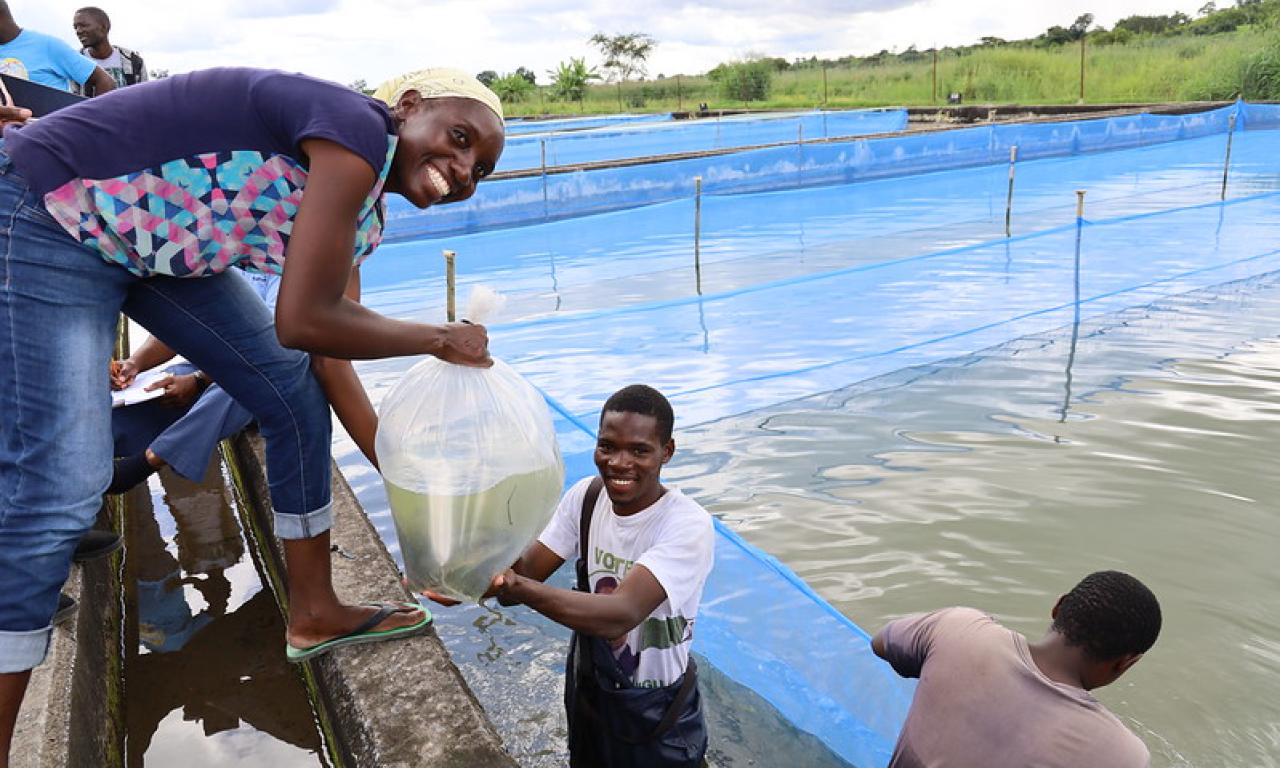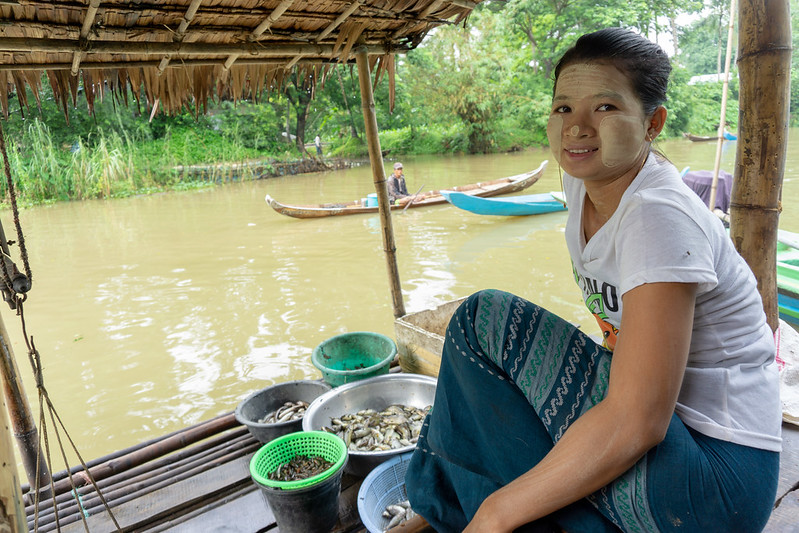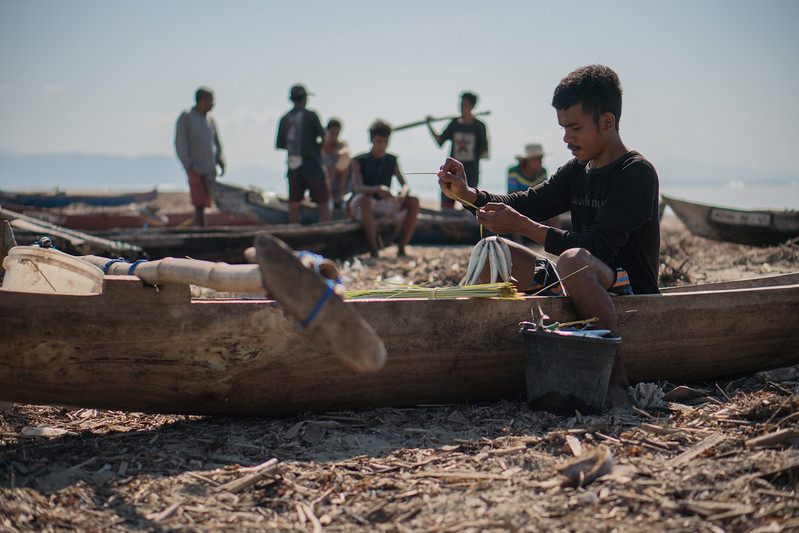
As impacts of the global pandemic COVID-19 continue to spread, young people face particular challenges, with having to worry about the health of their families, their workplaces or schools closing and access to food and other necessities. The CGIAR Research Program on Fish in Agri-Food Systems (FISH) - led youth study began over one year ago, before the COVID-19 situation had emerged, but we are and will be giving special attention to impacts on youth in fisheries and aquaculture in our COVID-19 research response. The study reported below provides a timely review of present knowledge, an important baseline for responding to the challenge of COVID-19, and putting into practice the concept of “building back better” aquaculture, fisheries and fish value chains in a youth inclusive manner.

What do we know about how youth participate in small-scale fisheries and aquaculture? Not enough.
“Fishing is tiring work” feels Ma Win, a 26 year old female living in the Ayeyarwady Delta of Myanmar, whose family practices small-scale fishing. “You are submerged in the water for long periods of time, pulling the net, sometimes working against the wind, all of which is physically taxing”. Ma Win would instead like to be a farmer and own her own plot of land, but due to her economic circumstances, does not see how this aspiration might materialise.
Likewise, Hassan, aged 25 from Oyo State, Nigeria could not find the type of employment he was looking for. I have always wanted to learn and build a career from the tiles business (house tiling), but I have not found an opportunity to learn the skill… I am a fish wholesaler, because I did not want to be idle and roaming the street, I need to have earnings, and I do not want to become a nuisance to the society” he says.
What do we know about how the lives of similar young people all over the world intersect with fisheries, aquaculture and the fish agri-food system? The short answer: Not much.
This is in spite of a recently burgeoning interest in the state of the world’s youth among government and development actors, driven by concerns about a rapidly expanding demographic set against a lack of employment opportunities to meet these numbers. For example, in Africa, only three million new jobs are created for the nearly 11 million young people entering the labour market every year.
Against this backdrop, under the framework of the FISH research program, the International Water Management Institute (IWMI) conducted an assessment of youth participation in aquaculture and small-scale fisheries in Africa and the Asia-Pacific, with a special focus on Egypt, Nigeria, Tanzania and Zambia, in Africa, and Bangladesh, Cambodia, Myanmar and Solomon Islands, in the Asia-Pacific region. One of the key objectives of the study was to assess the opportunities and challenges encountered by youth when they engage with these sectors for their livelihoods. The results of the study can be found here.
The study finds that there is little knowledge on how young people interact with the fish agri-food system, often hidden from research, data and policies. This lack of visibility of youth means that policy discourse, interventions and initiatives on promoting the sectors for youth livelihoods can tend to be based more on conjecture rather than empirical evidence.
From what we do know, it appears that working with fish and aquatic foods, particularly small-scale capture fisheries are not the first choice of livelihoods for most youth. There are a number of reasons as to why – for example, youth are constrained in accessing land, finances and other resources, and having a voice in decision-making in regard to fisheries. Other challenges include possessing limited knowledge and experience, and interacting with natural ecosystems and fishing grounds of in many circumstances diminishing productivity. Furthermore, small scale fisheries are often associated with low social status, and, in certain parts of the value chains, exploitative and discriminatory working conditions.

We know less about why the fish agri-food system might be attractive for youth. There is widespread expectation that the fast-growing aquaculture sector has the potential to provide a more ‘modern’ livelihood activity for youth, particularly in Africa where there are some positive results emerging from more pro-youth policies and investments. It is also believed that tighter integration of ICT and entrepreneurship approaches can make aquaculture more attractive for youth. However, these connections remain largely tenuous at this point, and there is a need for more evidence to back them.
The study also looked to research on youth engagement in the agriculture sector to provide us with a critical framework with which to compare with studies that were available in fisheries and aquaculture.
What are the next steps?
Existing research does not differentiate enough between to what extent many of the constraints and opportunities are also common to other social groups, or where they are more unique to youth and therefore can be points for youth-specific interventions.
They also do not account enough for the diversity within youth. Youth are not a homogeneous group of individuals, uniformly impacted by opportunities and constraints to engage in the agriculture sector, regardless of individual characteristics and circumstances such as gender and socio-economic status.
Fish and aquatic foods are increasingly seen as a key and growing component of the world’s food system, and with increasing attention on the Blue Economy as a new frontier for growth, this could potentially have several opportunities for engaging youth.
The FISH research program study proposes four inter-linked research pathways for improving our understanding of why, where, how, and which youth engage in fish agri-food systems and where this engagement should and could be strengthened. These include:
- Understanding the impact of economic, political and social drivers from global to local levels on youth involvement in fisheries and aquaculture
- Analyzing the policy architecture that influences youth involvement in fish agri-food systems
- Understanding the diversity among youth engagement in fisheries and aquaculture
- Building a youth-oriented approach to the policies and practices of fisheries and aquaculture
“ As attention moves towards quick and efficient recovery strategies post the COVID-19 crisis, now is the time to be thinking and acting in ways that do provide new and significant opportunities for youth to be part of the future fish agri-food system. This study is an important foundation of the research work towards equitable and engaging fisheries and aquaculture sectors, but much more can and needs to be done to uncover the potential of youth in fish and aquatic food systems.” – concludes, Dr Michael Phillips, Director of the CGIAR Research Program on Fish in Agri-Food Systems (FISH).
Disclaimer
The names Hassan and Ma Win have been modified to preserve the anonymity of the testimonials provided by the participants in this study.
Acknowledgments
The study was conducted as part of the CGIAR Research Program on Fish Agri-Food Systems led by WorldFish, together with the International Water Management Institute (IWMI) and three advanced research institutes: the Aquaculture and Fisheries Group at Wageningen University (WUR), the Australian Research Council Centre of Excellence in Coral Reef Studies at James Cook University (JCU), and the Natural Resources Institute at the University of Greenwich (NRI).
Authors: Indika Arulingam, Likimyelesh Nigussie, Sonali Senaratna Sellamuttu